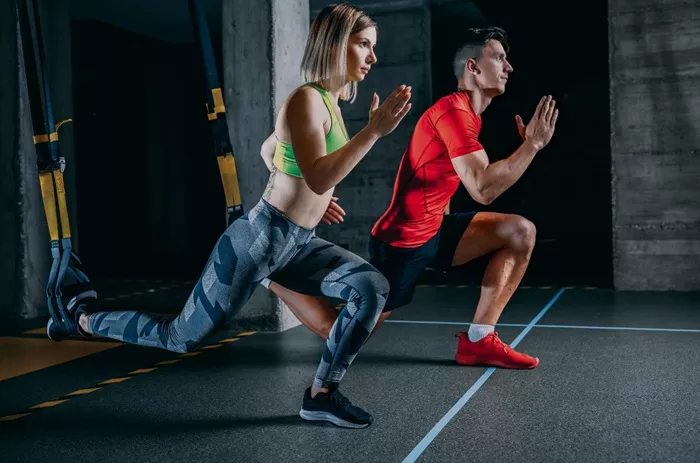Jump lunges are a high-intensity plyometric exercise. They target the muscles in the lower body. These include the quadriceps, hamstrings, glutes, and calves. This movement is a powerful way to build strength and agility. It also improves cardiovascular endurance.
How to Do Jump Lunges Correctly
Step 1: Start in a Basic Lunge
Stand upright. Take a step forward with your right foot. Bend both knees at 90 degrees. Keep your back straight. Your front knee should align with your ankle. Your back knee should be just above the floor.
Step 2: Jump and Switch Legs
Push off the ground. Jump upward with power. Switch legs while in the air. Land with your left leg forward. Return to the lunge position. Keep your core tight during the motion.
Step 3: Maintain Rhythm and Control
Repeat the motion. Continue alternating legs. Move in a controlled, steady rhythm. Avoid letting your knees wobble or collapse inward. Land softly to reduce joint impact.
Muscles Worked in Jump Lunges
Jump lunges work multiple muscles at once. This makes them a compound exercise. The main muscles involved include:
- Quadriceps
- Gluteus Maximus
- Hamstrings
- Calves
- Core stabilizers
These muscles are crucial for movement and posture. Strengthening them helps you move better and prevents injuries.
Benefits of Jump Lunges
1. Builds Strength and Power
Jump lunges require explosive energy. This builds fast-twitch muscle fibers. These fibers increase your strength and power. Athletes use jump lunges to boost performance.
2. Burns Calories Fast
This exercise raises your heart rate quickly. It combines cardio and strength training. This dual action burns more calories. It’s ideal for fat loss and muscle toning.
3. Improves Balance and Coordination
Jumping and switching legs challenges your stability. You need balance and coordination to land correctly. Over time, this improves your body control and movement skills.
4. Increases Heart Health
Jump lunges are a form of cardio. They get your heart pumping fast. This strengthens the heart and improves circulation. It helps manage weight and lowers the risk of heart disease.
Is It a Cardio or Anaerobic Exercise?
Jump lunges are both anaerobic and aerobic. The explosive movement is anaerobic. The continuous reps make it aerobic. This mix is good for building endurance and power.
People looking for an effective anaerobic exercise often include jump lunges in their training plans.
How to Add Jump Lunges to Your Routine
1. In a Warm-Up
Use jump lunges to activate your legs. Do a light version without jumping. This prepares the muscles for heavier movements.
2. In a cardio workout
Jump lunges can be added to circuits. Use them between upper-body moves. This keeps your heart rate up. It makes your workout more effective.
3. As a Main Lower Body Exercise
Use jump lunges as your main leg workout. Do them for 3-4 sets. Aim for 10-20 reps per leg. Rest 30 to 60 seconds between sets.
Variations of Jump Lunges
1. Weighted Jump Lunges
Hold dumbbells in each hand. This adds resistance. It increases strength gains.
2. Pulse Jump Lunges
Before you jump, pulse up and down in the lunge. This adds burn and makes the muscles work harder.
3. Jump Lunge to Squat
Perform a jump lunge. Then do a bodyweight squat. This combo targets multiple muscles and boosts endurance.
Common Mistakes and How to Avoid Them
1. Poor Landing Form
Always land softly. Bend your knees. Keep your joints safe. A hard landing can lead to knee or ankle injury.
2. Knees Caving Inward
Keep knees in line with your toes. Use a mirror or record yourself. Fix your form early to avoid injuries later.
3. Losing Balance
If you are off balance, slow down. Focus on form. Build stability before adding speed or weight.
Is Jump Lunge for Beginners?
Jump lunges are challenging. Beginners can start with stationary lunges. Once strong enough, progress to jumping. Listen to your body and build up gradually.
Safety Tips for Jump Lunges
- Warm up before doing jump lunges
- Use proper footwear with cushion
- Perform on a soft surface or gym mat
- Stay hydrated and breathe properly
- Rest if you feel sharp pain
Equipment Needed
No equipment is needed for bodyweight jump lunges. Optional tools include:
- Dumbbells for added weight
- Resistance bands for glute activation
- A soft mat for cushioning
Sample Workout Using Jump Lunges
Full Body Circuit (Repeat 3 Rounds)
Can You Do Jump Lunges at Home?
Yes, jump lunges are perfect for anaerobic training at home. You don’t need equipment or much space. A small open area and a mat are enough.
Who Should Avoid Jump Lunges?
People with knee injuries or balance issues should avoid jump lunges. Pregnant women or older adults should consult a doctor. Always listen to your body. Modify or skip if needed.
How Often Should You Do Jump Lunges?
Jump lunges can be done 2-3 times a week. Give muscles time to rest and recover. Avoid overtraining. Mix them with other exercises for a balanced plan.
Conclusion
Jump lunges are a powerful addition to any fitness routine. They build strength, improve cardio health, and enhance coordination. Whether at home or in the gym, jump lunges provide full-body benefits. Master the form, stay safe, and enjoy the results of this dynamic exercise.

